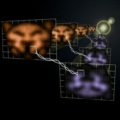
California Institute of Technology scientists have demonstrated how entanglement in the form of beams of light simultaneously propagating along four distinct paths can be detected with a surprisingly small number of measurements. Explaining their work in Science, H. Jeff Kimble, professor of physics at Caltech, and his colleagues show that quantum uncertainty relations can be used to identify entangled states of light that are only available in the realm of quantum mechanics.
Entanglement, which lies at the heart of quantum physics, is a state in which the parts of a composite system are more strongly correlated than is possible for any classical counterparts, regardless of the distances separating them. Entanglement in a system with more than two parts, or multipartite entanglement, is a critical tool for diverse applications in quantum information science, such as for quantum metrology, computation, and communication.
In the new experiment, a pulse of light was generated containing a single photon – a massless bundle, with both wave-like and particle-like properties, that is the basic unit of electromagnetic radiation. The team split the single photon to generate an entangled state of light in which the quantum amplitudes for the photon propagate among four distinct paths, all at once. This so-called W state plays an important role in quantum information science.
To enable future applications of multipartite W states, the entanglement contained in them must be detected and characterized. This task is complicated by the fact that entanglement in W states can be found not only among all the parts, but also among a subset of them. To distinguish between these two cases in real-world experiments, Steven van Enk and Pavel Luogovski from the University of Oregon developed a novel approach to entanglement detection based on the uncertainty principle. The demonstration of the detection of entanglement in multipartite W states is the key breakthrough of the Caltech group’s work.
The new approach to entanglement detection makes use of non-local measurements of a photon propagating through all four paths. The measurements indicate whether a photon is present, but give no information about which path it takes. “The quantum uncertainty associated with these measurements has allowed us to estimate the level of correlations among the four paths through which a single photon simultaneously propagates, by comparing to the minimum uncertainty possible for any less entangled states,” says Caltech researcher Kyung Soo Choi.
Correlations of the paths above a certain level signify entanglement among all the pathways; even partially entangled W states do not attain a similar level of correlation. A key feature of this approach is that only a relatively small number of measurements must be performed. Due to their fundamental structure, the entanglement of W states persists even in the presence of some sources of noise. This is an important feature for real-world applications of W states in noisy environments. The Caltech experiments have directly tested this property by disturbing the underlying correlations of the entangled state. When the correlations are purposely weakened, there is a reduction in the number of paths of the optical system that are entangled. And yet, as predicted by the structure of W states, the entanglement remains amongst a subset of the paths.
“Our work introduces a new protocol for detecting an important class of entanglement with single photons,” Papp explained. “It signifies the ever-increasing degree of control we have in the laboratory to study and manipulate quantum states of light and matter.”
Related
More quantum hi-jinx from Caltech
Physicists Create Quantum-Entangled Images
Quantum Computer Computes, While Not Operating
Too Much Uncertainty For Quantum Computing?








Comments are closed.